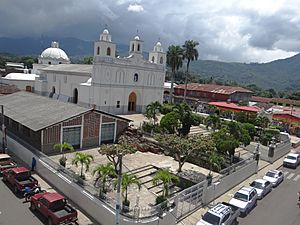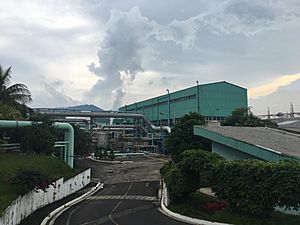Ahuachapán facts for kids
Quick facts for kids
Ahuachapán
|
||
|---|---|---|

Our Lady of the Assumption Parish
|
||
|
||
| Country | ||
| Department | Ahuachapán Department | |
| Founded | 1862 | |
| Area | ||
| • Municipality | 244.84 km2 (94.53 sq mi) | |
| • Metro | 244.84 km2 (94.53 sq mi) | |
| Elevation | 799 m (2,621 ft) | |
| Population | ||
| • Municipality | 135,325 | |
| • Density | 552.708/km2 (1,431.51/sq mi) | |
| • Urban | 34,102 | |
| • Metro | 135,325 | |
| Postal code |
AH-01
|
|
Ahuachapán is a city and the capital of the Ahuachapán Department in western El Salvador. It is located near the border with Guatemala. This makes it the westernmost city in El Salvador.
The city and its surrounding area cover about 244.84 square kilometers. In 2007, about 110,511 people lived there. Ahuachapán is known for its farms, especially for growing coffee.
Ahuachapán also has a special power plant that uses heat from the Earth (geothermal energy). There's also a power station that uses water (hydroelectric). You can see steam coming out of the ground in the mountains around the city.
This city is the birthplace of a famous Salvadoran poet named Alfredo Espino. It's also about an hour's drive from El Imposible, a national wildlife park.
Contents
History of Ahuachapán
Ahuachapán was first settled by Mayan people from the Poqomam tribe around the 5th century. Later, in the 15th century, the Izalcos people took over the area.
Ahuachapán officially became a city in El Salvador on February 11, 1862. It then became the capital of its department on February 9, 1899.
Geography and Climate
The city of Ahuachapán is located about 100 kilometers (62 miles) from San Salvador, the capital city of El Salvador. To the north, it shares a border with San Lorenzo and the country of Guatemala.
Ahuachapán is surrounded by several towns. These include San Lorenzo, Atiquizaya, Turín, Juayúa, Apaneca, and Tacuba. The weather in Ahuachapán is usually warm, with temperatures between 22°C and 27°C (72°F and 81°F).
The main river in the area is the Río Paz. This river forms a natural border between El Salvador and Guatemala.
Local Attractions to Visit
Main City Sights
Near the Iglesia La Asunción (a church), you'll find Francisco Menéndez Park. This park has a monument honoring General Francisco Menéndez, who was once the president of El Salvador. There's also a special plaque showing where he used to live.
The Central Plaza is a major attraction. It includes the Central Park, also known as Parque Concordia. Around the park, you'll see the City Hall, a modern building rebuilt after a fire in the 1950s. The town's main church, Iglesia de La Asunción, is over 100 years old. The Pasaje Concordia is a pedestrian-only street that was updated in the early 2000s.
Lagoon of El Espino
The Lagoon of El Espino is located four kilometers (about 2.5 miles) northwest of Ahuachapán city. It's along the main highway that goes to Guatemala. A very important event happened near this lagoon: the first battle in the history of independent Central America. This was the battle of Espino, which took place on March 12, 1822.
Other Natural Wonders
Ahuachapán is home to Los Ausoles, a fascinating area with geysers, steam vents, and bubbling hot springs. Other natural spots include Lagoon Morán, Atehuecillas, and Malacatiupán. Near Las Chinamas, you can find "Los Encuentros," where the Río Paz and the El Pulula river (from Guatemala) meet. "La Poza de la Yerba Buena" is a beautiful spot in the Pueblo Viejo river.
You can also visit El Arco Durán, which is a copy of a famous French arch. Nearby, you can enjoy delicious and traditional Salvadoran "Pupusas."
Administrative Divisions
Cantons of Ahuachapán
The municipality of Ahuachapán is divided into 29 smaller regions called cantons. These cantons help organize the different areas within the municipality.
Some of these cantons include Ashapuco, Chancuyo, Chipilapa, Cuyanausul, El Anonal, El Roble, El Tigre, and Las Chinamas.
Ahuachapán Weather
| Climate data for Ahuachapán (1991–2020) | |||||||||||||
|---|---|---|---|---|---|---|---|---|---|---|---|---|---|
| Month | Jan | Feb | Mar | Apr | May | Jun | Jul | Aug | Sep | Oct | Nov | Dec | Year |
| Mean daily maximum °C (°F) | 30.7 (87.3) |
32.0 (89.6) |
33.2 (91.8) |
33.6 (92.5) |
32.0 (89.6) |
30.1 (86.2) |
30.4 (86.7) |
30.5 (86.9) |
29.7 (85.5) |
29.6 (85.3) |
30.0 (86.0) |
30.3 (86.5) |
31.0 (87.8) |
| Daily mean °C (°F) | 22.4 (72.3) |
23.1 (73.6) |
24.0 (75.2) |
24.9 (76.8) |
24.6 (76.3) |
23.7 (74.7) |
23.9 (75.0) |
23.8 (74.8) |
23.2 (73.8) |
23.1 (73.6) |
22.8 (73.0) |
22.5 (72.5) |
23.5 (74.3) |
| Mean daily minimum °C (°F) | 17.1 (62.8) |
17.6 (63.7) |
18.4 (65.1) |
19.6 (67.3) |
20.2 (68.4) |
19.8 (67.6) |
19.8 (67.6) |
19.6 (67.3) |
19.6 (67.3) |
19.4 (66.9) |
18.4 (65.1) |
17.5 (63.5) |
18.9 (66.0) |
| Average precipitation mm (inches) | 1.1 (0.04) |
4.2 (0.17) |
5.7 (0.22) |
30.3 (1.19) |
151.2 (5.95) |
275.7 (10.85) |
278.1 (10.95) |
286.1 (11.26) |
295.3 (11.63) |
177.4 (6.98) |
38.9 (1.53) |
5.9 (0.23) |
1,549.7 (61.01) |
| Average relative humidity (%) | 68 | 68 | 67 | 70 | 77 | 82 | 79 | 81 | 85 | 82 | 74 | 72 | 75.4 |
| Source: Ministerio de Medio Ambiente y Recursos Naturales | |||||||||||||
Economy and Industries
The most important industries in Ahuachapán are geothermal energy, which uses heat from the Earth to create power. Other key industries include growing and processing coffee, making textiles (fabrics), and producing construction materials.
Traditions and Celebrations
The most important tradition in Ahuachapán is the Día de los Farolitos (Day of the Little Lantern Lights). This event happens every year on September 7th. People have a parade and a celebration to honor the birth of the Virgin Mary.
Notable People from Ahuachapán
Many interesting people have come from Ahuachapán. Here are a few:
- Alfredo Espino
- Ricardo Trigueros Deleón
- Humberto Escapini
- Roberto Galicia
- Miguel Ángel Espino
- Santiago José Celis
- Mauricio Linares Aguilar
- Francisco Menéndez
- Alvaro Magaña Borja
- Timoteo Menéndez
- Mario Benjamín Castro
Sports in Ahuachapán
The local professional football (soccer) team in Ahuachapán is called Once Municipal (Municipal Eleven). Their home stadium is Estadio Simeón Magaña.
See also
 In Spanish: Ahuachapán para niños
In Spanish: Ahuachapán para niños





